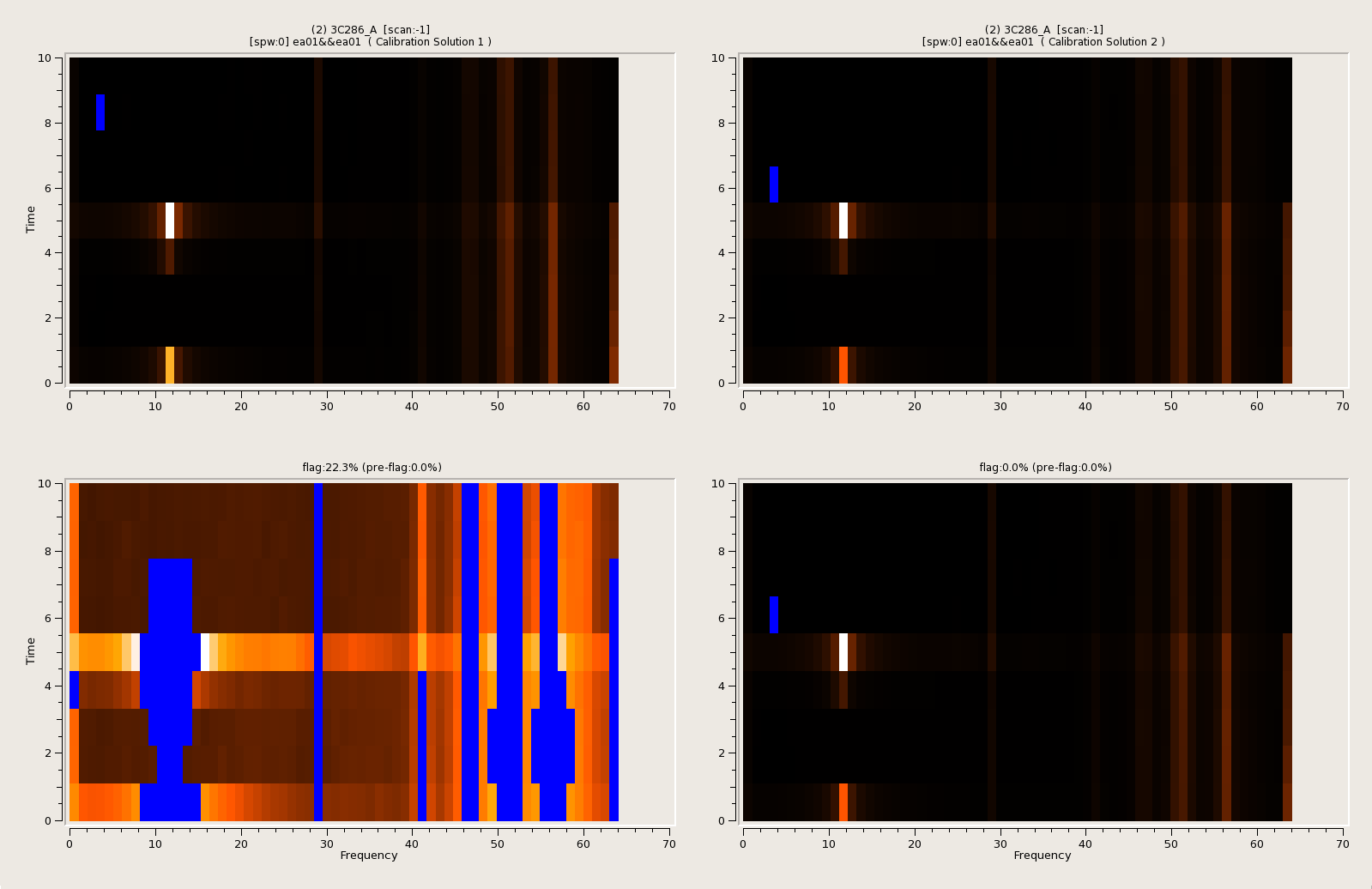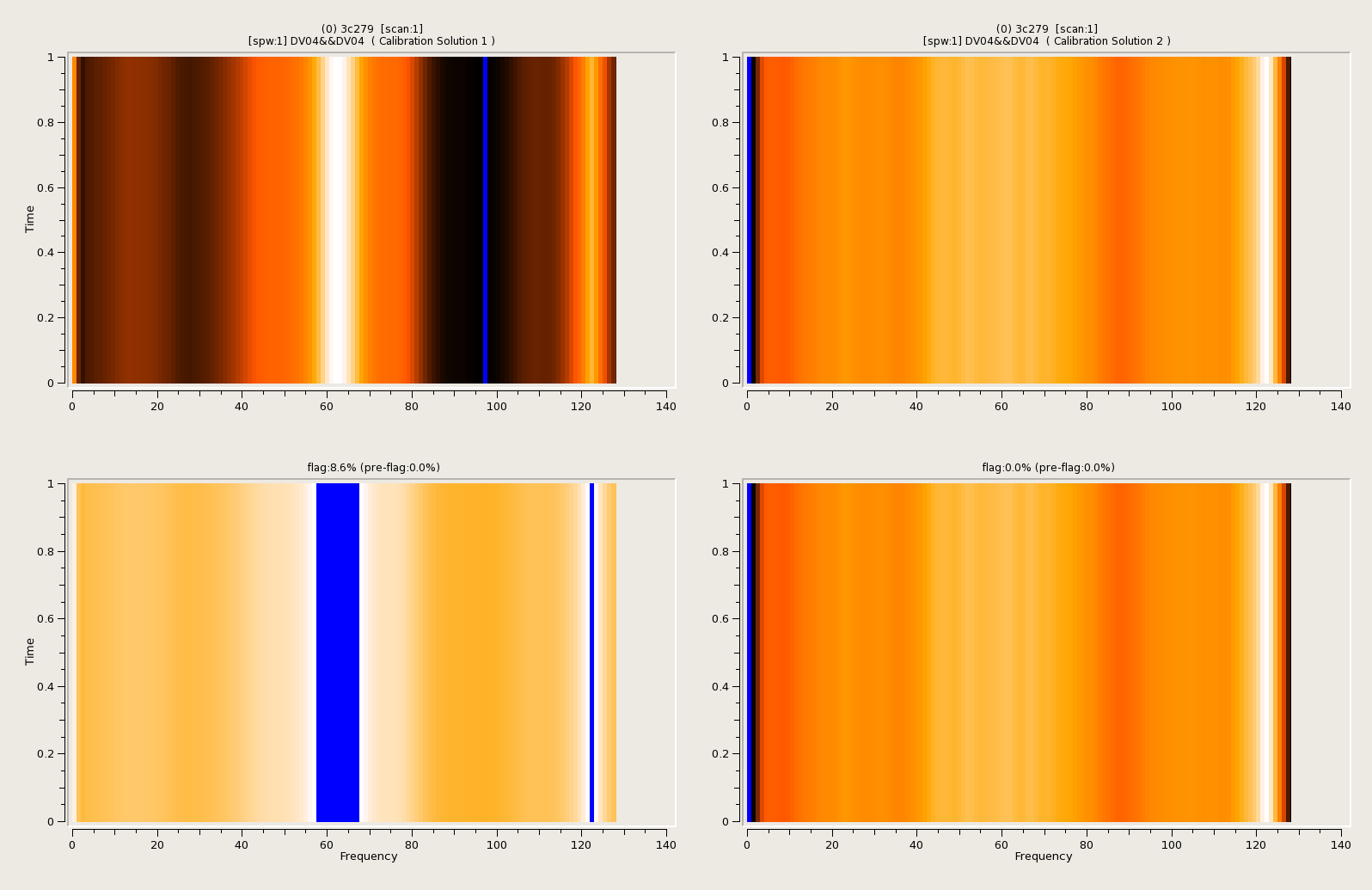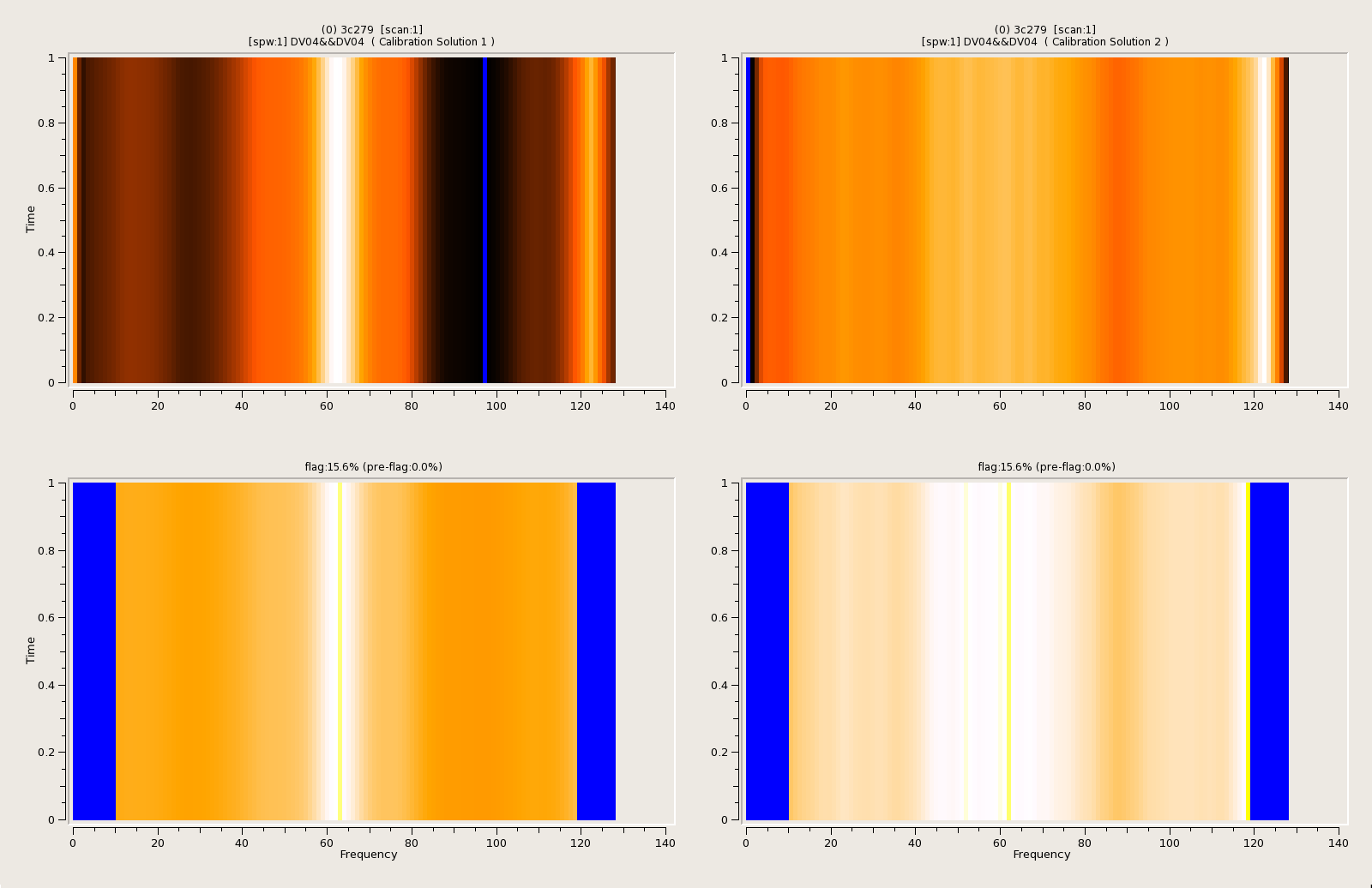



Next: 3 Frequently Asked Questions
Up: 2 Running the flagger
Previous: 2.3 Summaries, displays, reports
Contents
Subsections
The new Calibration Table format can be handled by the AgentFlagger tool in a
transparent way, just like a Measurement Set Table. There is an open-time check
that inspects the table type and uses the appropriate FlagDataHandler
implementation for all the I/O operations:
CASA <2>: af.open('X7ef.tsys')
INFO AgentFlagger::open Table type is Calibration
Out[2]: True
In principle support for the new Calibration Table format has been introduced
transparently, so it is possible to flag them using any of the already available
modes for Measurement Sets. However, due to the nature of the data in
calibration tables, it only makes sense to use the following flag agent groups:
- Auto-flagging (outliers detection) agents: clip, tfcrop, rflag:
af.open('X7ef.tsys')
af.selectdata()
agentClip={'mode':'clip','clipzeros':True,'clipminmax':[0.,600.],'datacolumn':'FPARAM'}
af.parseagentparameters(agentClip)
af.init()
af.run()
af.done()
- Manual flagging (meta-data selections like antenna/time-range):
af.open('X7ef.tsys')
af.selectdata()
agentManual={'mode':'manual','antenna':'DV09'}
af.parseagentparameters(agentManual)
af.init()
af.run()
af.done()
- Auxiliary modes: unflag, summary, display
af.open('X7ef.tsys')
af.selectdata()
agentSummary={'mode':'summary'}
af.parseagentparameters(agentSummary)
af.init()
summary = af.run()
af.done()
Notice that the parameters names and types are the same as described in the
flagdata command-line help.
- For the autoflagging agents (clip, tfcrop, rflag) it is possible to
choose the column to operate with, using the 'datacolumn' parameter, being 'FPARAM',
'PARAMERR' and 'SNR' the currently supported columns:
agentClip={'mode':'clip','clipminmax':[0.,6.],'datacolumn':'PARAMERR'}
af.parseagentparameters(agentClip)
af.init()
...
INFO Clip::setAgentParameters data column is PARAMERR
But notice that the default datacolumn is FPARAM:
agentClip={'mode':'clip','clipminmax':[0.,6.]}
af.parseagentparameters(agentClip)
af.init()
...
INFO Clip::setAgentParameters data column is FPARAM
- And it is also possible to choose the element of interest to inspect for
flagging, trough the correlation parameter, specifying a list of comma-separated
elements or 'ALL' to select all the elements (which is also the default):
agentClip={'mode':'clip',clipminmax':[0.,600.],'datacolumn':'FPARAM','correlation':'Sol1'}
af.parseagentparameters(agentClip)
af.init()
...
INFO Clip::setAgentParameters Visibility expression is REAL SOL1
agentClip={'mode':'clip','clipminmax':[0.,600.],'datacolumn':'FPARAM','correlation':'ALL'}
af.parseagentparameters(agentClip)
af.init()
...
INFO Clip::setAgentParameters Visibility expression is REAL SOL1,SOL2
Also notice that the default expression is 'ALL':
agentClip={'mode':'clip','clipminmax':[0.,6.]}
af.parseagentparameters(agentClip)
af.init()
...
INFO Clip::setAgentParameters Visibility expression is REAL SOL1,SOL2
As far as meta-data selection is concerned, we are bounded to what MSSelection
interface for Calibration Tables offers (currently only field, spw and antenna
selections). There are two way to apply meta-data selections, with can be used
independently or combined together:
- FlagDataHandler selection (global): Create a sub-table with the selection
to be used by all the agents. The data selection parameters have to be parsed
trough the selectdata() method of the AgentFlagger tool:
af.open('X7ef.tsys')
af.selectdata(field='TW Hya')
agentManual={'mode':'manual'}
af.parseagentparameters(agentManual)
af.init()
af.run()
af.done()
- Agent selection (specific to each agent): To restrict the rows that each
agent inspect for flagging. The data selection parameters can be parsed as
normal agent parameters:
af.open('X7ef.tsys')
af.selectdata()
agentManual={'mode':'manual','antenna':'DV09'}
af.parseagentparameters(agentManual)
af.init()
af.run()
af.done()
- Combined selection : To iterate only trough a global selection, and at the
same time have each agent inspecting a particular group of rows for flagging:
af.open('X7ef.tsys')
af.selectdata(field='TW Hya')
agentManual={'mode':'manual','antenna':'DV09'}
af.parseagentparameters(agentManual)
af.init()
af.run()
af.done()
As with MeasurementSet tables, the re-factored flagger framework allows running
several flagging agents at the same time, to reduce I/O overhead, for instance:
- Combination of tfcrop and rflag:
af.open('cal.fewscans.bpass')
af.selectdata()
agentRflag={'mode':'rflag','datacolumn':'PARAMERR','correlation':'Sol1'}
agentTfcrop={'mode':'tfcrop','datacolumn':'PARAMERR','correlation':'Sol1'}
af.parseagentparameters(agentRflag)
af.parseagentparameters(agentTfcrop)
af.init()
af.run(writeflags=True)
af.done()
Figure 10:
Rflag and TFCrop agents combined in a single run applied on a EVLA
band-pass calibration table
 |
- Unflag + Clip + Display
af.open('X7ef.tsys')
af.selectdata()
agentUnflag={'mode':'unflag'}
agentClip={'mode':'clip','clipminmax':[0.,600.],'datacolumn':'FPARAM','correlation':'Sol1'}
agentDisplay={'mode':'display','datadisplay':True}
af.parseagentparameters(agentUnflag)
af.parseagentparameters(agentClip)
af.parseagentparameters(agentDisplay)
af.init()
af.run(writeflags=True)
af.done()
Figure 11:
Clipping agent operating on ALMA TSys CalTable (TW Hya Science
Verification data)
 |
- Unflag + Manual Selection (channel edges) + Summary
af.open('X7ef.tsys')
af.selectdata()
agentUnflag={'mode':'unflag'}
agentManual={'mode':'manual','spw':'*:0~9;118~127'}
agentDisplay={'mode':'display','datadisplay':True}
af.parseagentparameters(agentUnflag)
af.parseagentparameters(agentManual)
af.parseagentparameters(agentDisplay)
af.init()
af.run(writeflags=True)
af.done()
Figure 12:
Clipping agent operating on ALMA TSys CalTable (TW Hya Science
Verification data)
 |
- Unflag + Manual Selection (antenna) + Summary
af.open('X7ef.tsys')
af.selectdata()
agentUnflag={'mode':'unflag'}
agentManual={'mode':'manual','antenna':'DV09'}
agentSummary={'mode':'summary'}
af.parseagentparameters(agentUnflag)
af.parseagentparameters(agentManual)
af.parseagentparameters(agentSummary)
af.init()
summary = af.run(writeflags=True)
af.done()
CASA <12>: summary
Out[12]:
{'nreport': 2,
'report0': {'antenna': {'DV04': {'flagged': 0.0, 'total': 14336.0},
'DV06': {'flagged': 0.0, 'total': 14336.0},
'DV07': {'flagged': 0.0, 'total': 14336.0},
'DV08': {'flagged': 0.0, 'total': 14336.0},
'DV09': {'flagged': 14336.0, 'total': 14336.0},
'DV10': {'flagged': 0.0, 'total': 14336.0},
'PM01': {'flagged': 0.0, 'total': 14336.0},
'PM02': {'flagged': 0.0, 'total': 14336.0},
'PM03': {'flagged': 0.0, 'total': 14336.0}},




Next: 3 Frequently Asked Questions
Up: 2 Running the flagger
Previous: 2.3 Summaries, displays, reports
Contents
R. V. Urvashi
2012-11-01


